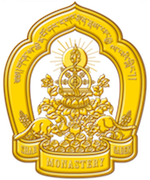Education Department
Shar Gaden Educational Project
Generally an educational project is considered to be a most productive and resourceful committee worldwide, especially within a Tibetan Buddhist monastery, where it rolls out major undertakings, such as education initiatives, monks’ tour projects, educational spending, etc. It is the second largest association in the monastery and the most active after the administrative office.
In the past, it had organized many monks’ tour projects to European and Asian countries to share the wisdom of the Buddha Dharma and raise funds which are directly utilized for daily food for monks, robes, educational materials and medical healthcare. The educational project of Shar Gaden is maintain by elected staff members led by Geshe Phuntsok Tsultrim(former director of Gaden Shartse educational project)
2) Geshe Jampa Kunchok - General Secretary
3) Ven Lobsang Dhongag - Assisting Secretary
4) Ven Lobsang Tenpa - Chief Accountant
5) Ven Ngawang Khenrab - Treasurer
6) Ven Tsultrim Choephel - Member
Monastic Education
Shar Gaden School located in Mundgod, South India, currently has 450 students with 20 teachers, including 10 regular teachers. The supreme head of the whole department is the Principal, who is also a director of the library, chosen unanimously by the monks during the general election. A candidate for this position has to be holder of Geshe Lharampa, the highest monastic qualification, equivalent of a Ph.D. or D.D. The students engage in the daily dharma practice and activities separately from the rest of the monks under the patronage of general teachers who are all former students. The students attend early morning puja session where they are served breakfast. It begins at 6:00am and lasts until 7:30am. The duration of a pujas depends of what kind of puja a benefactor has requested. Then regular classes start at 8:00am and last until 10:30am. The school monitor rings the bell at the beginning and end of every session.
When the students are not in school class sessions, their personal teachers take responsibility of providing monastic education by letting them focus on ritual practice, memorizing scriptures, making butter sculptures and color mandalas, Tibetan hand-writing, dharma related drawing of Eight Auspicious Signs, Kalachakra etc. in the lunch break. The afternoon school starts at 2:00pm, with an additional subject of philosophy, each hour-long session is separated by 15 minutes break. It goes until 4:30pm.
The school examination is divided into two events: half-yearly and annual, the difference being only the number and level of subjects. After the completion of the annual exam, the promotion of the classes takes place, where all individuals who have passed the exam are promoted to the next level. The highest class of non-debate-goers will be considered as eligible to participate in the evening debate session and they find a personal tutor by offering white scarf with fresh fruits in the traditional way and start from color class.



